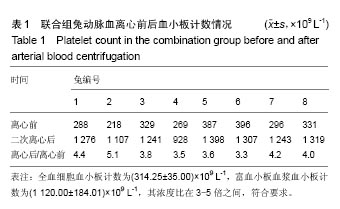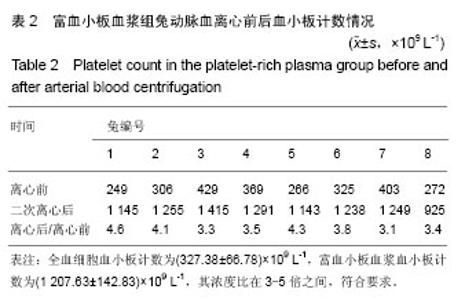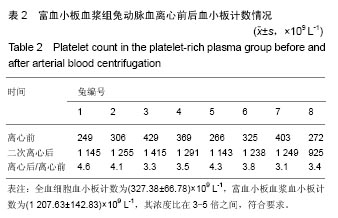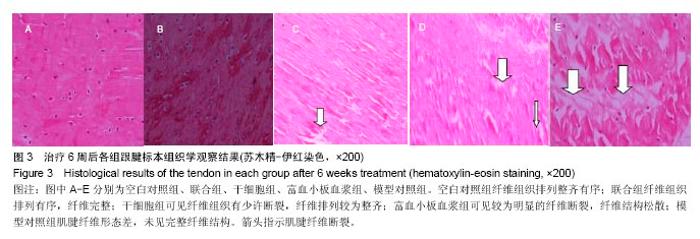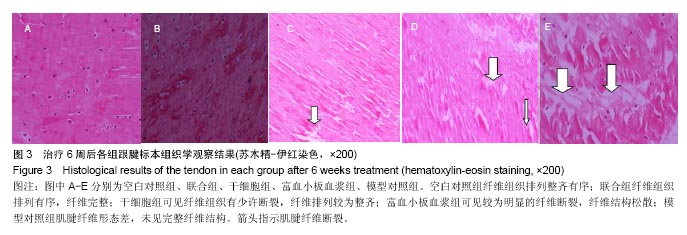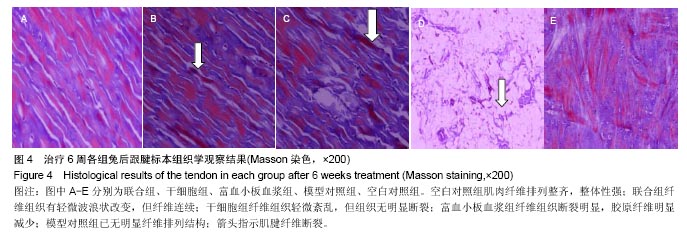| [1]Park CG,Joo MW,Jeong J,et al.Evaluation of the effects of the combination of autologous mesenchymal stem cells and platelet-rich plasma on structural bone allograft healing.Cell Tissue Bank. 2017; 24(12):35-36.[2]Kim SJ,Song DH,Park JW,et al.Effect of Bone Marrow Aspirate Concentrate Platelet-Rich Plasma on Tendon Derived Stem Cells and Rotator Cuff Tendon Tear.Cell Transplant.2017;20(1):41-42.[3]Joshi Jubert N,Rodríguez L,Reverté-Vinaixa MM,et al.Platelet-Rich Plasma Injections for Advanced Knee Osteoarthritis: A Prospective, Randomized, Double-Blinded Clinical Trial.Orthop Sports Med. 2017; 5(2):2325967116689386.[4]Hu C,Zhang Y,Tang K,et al.Downregulation of CITED2 contributes to TGF-βmediated senescence of tendon-derived stem cells.Cell Tissue Res.2017;13(1)22-23.[5]秦川.实验动物学[M].北京:人民卫生出版社,2010.[6]Khan MH,Li Z,Wang JH.Repeated exposure of tendon to prostaglandin -E2 leads to localized tendon degeneration.Clin J Sport Med.2005;15(1):27-33.[7]Landesberg R,Roy M,Glickman RS.Quantification of growth factor levels using a simplified method of platelet-rich plasma gel preparation. J Oral Maxillofac Surg.2000;58(3):297-300[8]Wang JH,Nirmala X.Application of Tendon Stem/Progenitor Cells and Platelet-Rich Plasma to Treat Tendon Injuries.Oper Tech Orthop.2016; 26(2):68-72.[9]周游,唐康来.肌腱病模型研究进展[J].中国运动医学杂志, 2013,32(9): 829-830.[10]Wang JH,Jia F,Yang G,et al.Cyclic mechanical stretching of human tendon fibroblasts increases the production of prostaglandin E2 and levels of cyclooxygenase expression: a novel in vitro model study. Connect Tissue Res.2003;44(3-4):128-133.[11]Petersen W,Hohmann G.Collagenous fibril texture of the gliding zone of the human tibialis posterior tendon.Foot Ankle Int.2001;22:126-132. [12]Ji RR,Xu ZZ,Wang X,et al.Matrix metalloprotease regulation of neuropathic pain.Trends Pharmacol Sci.2009;30:336-340.[13]吴骁,何本祥,咸杰,等.富血小板血浆修复膝关节骨性关节炎[J].中国组织工程研究,2016,20(42):6259-6264. [14]Knezevic NN,Candido KD,Desai R,et al.Is Platelet-Rich Plasma a Future Therapy in Pain Management?Med Clin North Am.2016;100(1):199-217.[15]Kajikawa Y,Morihara T,Sakamoto H,et al.Platelet-rich plasma enhances the initial mobilization of circulation-derived cells for tendon healing.J Cell Physiol.2008;215:837-845.[16]Kaux JF,Delvaux F,Oppong-Kyei J,et al.Cross-cultural Adaptation and Validation of the Victorian Institute of Sport Assessment-Patella Questionnaire for French-Speaking Patients With Patellar Tendinopathy. J Orthop Sports Phys Ther.2016;46(5):384-390.[17]Kaux JF,Delvaux F,Oppong-Kyei J,et al.Validity and reliability of the French translation of the VISA-A questionnaire for Achilles tendinopathy. Disabil Rehabil.2016;38(26):2593-2599.[18]Cross JA,Cole BJ,Spatny KP,et al.Leukocyte-Reduced Platelet-Rich Plasma Normalizes Matrix Metabolism in Torn Human Rotator Cuff Tendons.Am J Sports Med.2015;43(12):2898-2906. [19]Spiesz EM,Thorpe CT,Chaudhry S,et al.Tendon extracellular matrix damage, degradation and inflammation in response to in vitro overload exercise.J Orthop Res.2015;33(6):889-897.[20]Jeon YR,Jung BK,Roh TS,et al.Comparing the Effect of Nonactivated Platelet-Rich Plasma, Activated Platelet-Rich Plasma, and Bone Morphogenetic Protein-2 on Calvarial Bone Regeneration.J Craniofac Surg.2016;27(2):317-321. |



